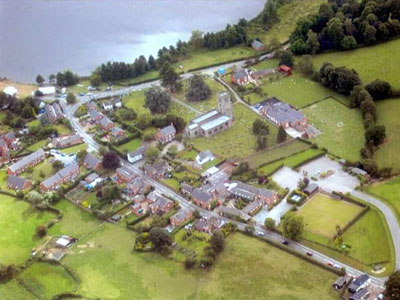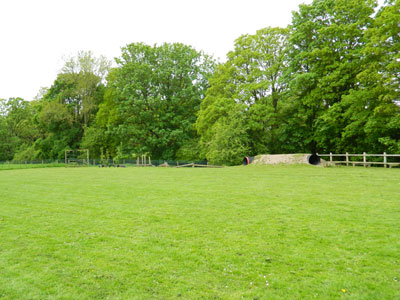About Hanmer

Hanmer is situated on the Welsh border between Whitchurch and Wrexham. It is a small village, proud of its rural heritage and surrounded by natural beauty.
Hanmer village sits in peaceful tranquillity by its shining mere overlooked by its large church. A public path runs through meadow and woodland down the east side of the mere, or glacial lake, which is a quiet refuge for many water birds including Crested Grebe, Swans, Canada Geese, Moorhen and friendly Mallard. From the mere-side road the visitor passes through ornate iron gates, which were designed by Robert Davies of Bersham, into a large graveyard which sweeps uphill to the church.
Around Church Square to the east of the church are the early 18th century vicarage and the half-timbered Church Cottage, the oldest house in the village. Closer to the mere is the ‘picture postcard’ thatched, black-and-white ‘Magpie Cottage’.
Facing the west front of the church is one of the oldest schools in Wales, having been in continuous use since its opening in 1676. The Welsh Assembly sympathetically redeveloped it in 2001 to a very high standard.
Hanmer probably takes its name from the Anglo-Saxon Hagena who established a holding there which acquired the name of Hagenamere. St. Chad is reputed to have baptised converts in nearby St Chad’s Well or Lyn Bedydd in AD 670.

Edward 1st, after his conquest of Wales, gave the area to Sir Thomas de Macclesfield. His grandson took the name of the village and the Hanmer family have been in Hanmer ever since. The twelfth century church was the setting in 1383 for the marriage of Margaret Hanmer to Owain Glyndwr, the man many see as the greatest Welshman of all time. That church was destroyed by fire in 1463 during the Wars of the Roses. It was rebuilt at the expense of Margaret Beaufort, wife of Lord Thomas Stanley and mother of Henry Tudor (Henry VII). The Tudor Rose motif, seen throughout the church, refers back to that time.
During the Civil War Roundhead troops from Nantwich invaded the village and stabled their horses in St. Chad’s. By order of Oliver Cromwell the ancient Churchyard Cross was thrown down and was only set up again at the southeast corner of the church in 1739. On the 20th June 1643 a large body of these Parliamentarian horse and dragoons was ambushed near Hanmer mere by Welsh Royalists and ‘cut to pieces’ in a skirmish.
The ‘Great Fire’ of Hanmer on 3rd February 1889 destroyed the magnificent interior woodwork, windows and roof of the church and threatened the whole village. Many fires were beaten out on thatched roofs of the nearby houses. The new box ceiling of the church has carvings designed and made by village youths in woodwork classes. Sadly work came to a sudden unfinished end when the young men went to the first World War. There are also beautifully carved screens and fitments from that time and the stained glass includes three Kempe windows.
Hanmer is also a place of poets. The Welsh gentleman poet Dafydd ab Edmund lived at Hanmer Hall. He won the chair at the Welsh National Eisteddfod at Carmarthen in 1451 and established the rules for writing Welsh poetry. In. 2001 Hanmer again came to national attention as the setting for the award winning autobiography ‘Bad Blood’ by Lorna Sage. Her eccentric grandfather who dominates the book was vicar of Hanmer when the great Welsh poet R. S. Thomas was curate in Hanmer.





